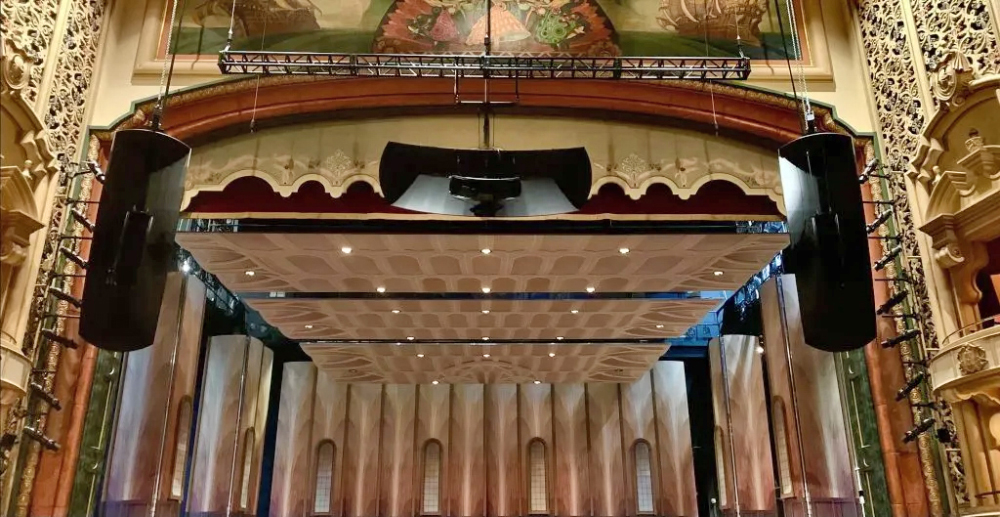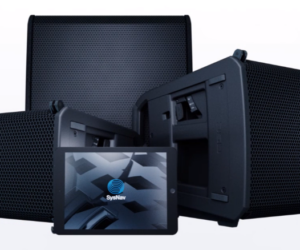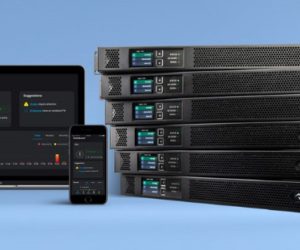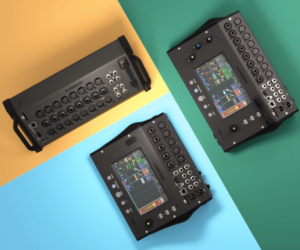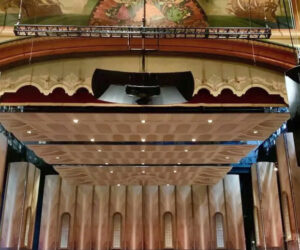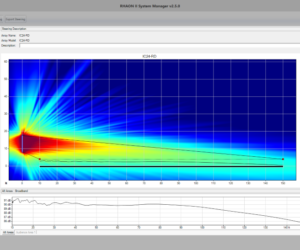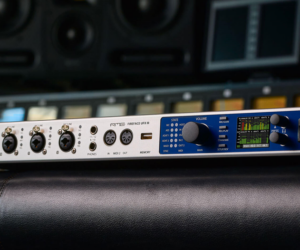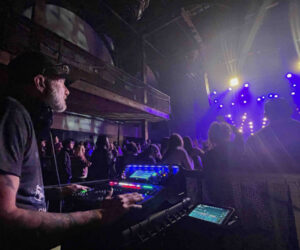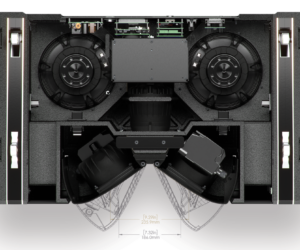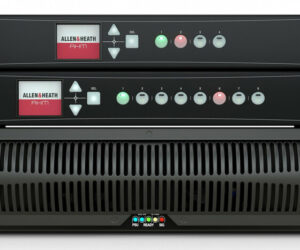Ocean Way Audio, renowned for developing loudspeakers for professional recording studios, has made its first foray into the world of live sound. They have applied their expertise from that market to introduce AeroWave technology, which aims to bring live audiences closer to the studio experience the company is known for.
Specifically, Ocean Way was founded in 1973 by five-time Grammy Award-winning engineer and producer Allen Sides, with the new AeroWave series designed and engineered by a team of industry veterans that includes Cliff Henricksen (director of new technologies), Bruce Marien (director of engineering), Ernie Woody (director of production and operations) and CEO/owner Sides.
The initial design came about in 2020 as a custom loudspeaker for the Granada Theater in Santa Barbara, CA. Grenada’s management approached Sides for a product that could provide clean and intelligible audio throughout the audience during the venue’s sonically diverse live performances, ranging from symphonic orchestras to rock bands.
“For decades, I have dedicated my expertise in production, engineering, studio design, and monitor system design to help many of the world’s greatest artists achieve gold and platinum status with their recordings,” Sides explains. “The listening experience in the studio environment after a track is mastered is beyond glorious. Artists, producers, and engineers have the luxury of experiencing music in a way that is simply indescribable.
“Sadly, audiences never really get to enjoy this caliber of sonic experience in the world of live shows and events. The impetus and driving force behind the AeroWave system is to now create that Ocean Way Audio studio experience for the audience – full spectrum, true hi-fi, true stereo.”

Addressing Issues
The unique design approach of AeroWave is intended to reduce interference between individual transducers, a compromise inherent to many existing sound reinforcement options. Since the early days of amplified sound, a prominent approach to the problem of needing more sound – whether coverage area or SPL – is to array multiple loudspeakers together. At first, this meant ground-stacked PA systems grew taller, wider, or both. Nowadays, vertically-oriented line array systems are more often called upon. In either case, the spatial assembly of individual components gives rise to acoustic interference between sources.
In other words, arrays exhibit comb filtering, or localized peaks and dips in frequency response throughout the coverage area. Line arrays exhibit this behavior in the vertical direction, and the ground stacks of yore in both horizontal and vertical directions.
Because these issues vary throughout the coverage area and are unique to each location, they cannot be fully solved with signal processing. Fixing one location via equalization can increase the havoc present in other locations. Experienced operators must know what problems can be corrected for, and what problems will vary throughout the audience area.
AeroWave is engineered to reduce interactions between its individual components, allowing for increased spatial uniformity and simplified drive and processing approaches over conventional arrayed systems. It consists of a large low-frequency horn, in which each entrance has a narrow vertical pattern, along with a smaller, coaxially-mounted high-frequency horn designed to have the same coverage. The purpose is to achieve maximum spectral uniformity, high output, and minimal interference between the individual transducers that make up AeroWave.

“AeroWave is literally a half-century dream come true. As it seems, I’ve been working my entire professional life to create the ideal large format device that delivers coherent single-point source output and yields full-spectrum coverage across its entire dispersion pattern, along with generating SPL capabilities typically only achieved through a large array of high-performance sources,” says Cliff Henricksen, director, new technology for the company. “AeroWave has been made possible through the evolution of modern constant directivity horns and the emergence of compact neodymium magnetic circuits meshed with our own proprietary manifolding and system architecture.”
“Hearing AeroWave’s debut at the Granada Theater with ever-familiar recordings by Allen Sides was truly akin to the experience residing in my own recording studio via Ocean Way HR4 monitors. Adding to that is an enormous stereo image, which sounds a mile wide in The Granada, and the experience is maintained at the far extents of the room, a long-dreamed sonic experience for the musical arts.”
Refresher Course
Before discussing AeroWave further, here is a refresher on the behavior of sound propagation from point source and line array systems. The intensity of sound emanating from a single point in space – perhaps, one loudspeaker – obeys the inverse square law. Its level decreases by a factor of four, or 6 dB, per doubling of distance from the source. Sound from an ideal line array system, defined as an infinite length of closely-spaced sources, decays by only a factor of two per doubling of distance, or 3 dB.
Practicality dictates that sound systems must be of finite size, so this ideal behavior cannot be fully realized. For a line of finite length, behavior at a particular frequency is presented in two zones: the near field and the far field. Within the former, sound level decreases at the expected 3 dB per doubling of distance. Within the latter, the behavior reverts back to that of a point source, decaying 6 dB per doubling of distance.

The transition point between the near and far field, called the “critical distance,” occurs farther away as either frequency or line length increase. For the mathematically inclined, the equation For critical distance is: R = H^2 / λ, where R is the critical distance, H is the line length, and lambda is the wavelength of the frequency in question. Therefore, for shorter line lengths or lower frequencies, the critical distance becomes closer.
As an example, take an array seven feet in length. Its critical distance at 1000 Hz will be about 45 feet. At 100 Hz, it will be merely 4.5 feet, meaning that it will behave like a typical point source for everyone in the audience. A useful conclusion to draw is that longer lines offer better control over low frequency behavior.
Spectrally Consistent
AeroWave is well suited for situations where point source technology doesn’t provide enough power but the limitations of line arrays cause unwanted drawbacks. As a first example, consider a venue where a shorter line length is necessary, perhaps due to weight or sight line restrictions. The designer of a line array system must balance behavior in the nearfield and the far field, very different at high and low frequencies, to develop the best compromise for their circumstance.
AeroWave is intended to be spectrally consistent within its coverage angle, removing many of these concerns. For audience geometries requiring a large amount of total splay from a line array system, the 90 degree vertical coverage of AeroWave offers a compelling option while simplifying the design process and drive system.

On other topics that will appeal to installers, AeroWave is currently available in two formats; the AW9045 has a 90-degree horizontal, 45-degree vertical dispersion, and the AW9090 is 90 by 90 degrees. GLL (Generic Loudspeaker Library) files viewable in EASE and EASE Focus acoustic simulation software are currently available for the AW9045 and will soon be available for the AW9090 as well.
The GLL files allow users of AeroWave to more accurately model and visualize the performance of the loudspeakers in various configurations and environments, helping them to make more informed decisions about placement as well as EQ settings and other aspects of system design and optimization.
Both the AW9045 and AW9090 systems ship with a DSP unit, the required power amplifiers, and S218AW dual 18-inch subwoofers that are designed to deliver tight, defined bass down to a stated 20 Hz. Typically, an AW9045 system uses four S218AW in a stereo configuration while an AW9090 system uses six S218AW in a stereo configuration. To commence performance, all that’s required are stereo sends (AES3 or analog XLRs), and an outside processor can be deployed to address aspects such as correcting for the room, if necessary.
“An extraordinary amount of time and meticulous attention to detail is placed into all of our speaker lines and into every build,” concludes Ernie Woody, director, production and operations for Ocean Way. “AeroWave’s intricate construction, true handbuilt nature and exacting testing protocols qualify it for ‘bespoke’ status. We go to great lengths to match critical components to ensure the performance of our systems. Allen Sides takes a hands-on approach to ensure each system meets his expectations.”


